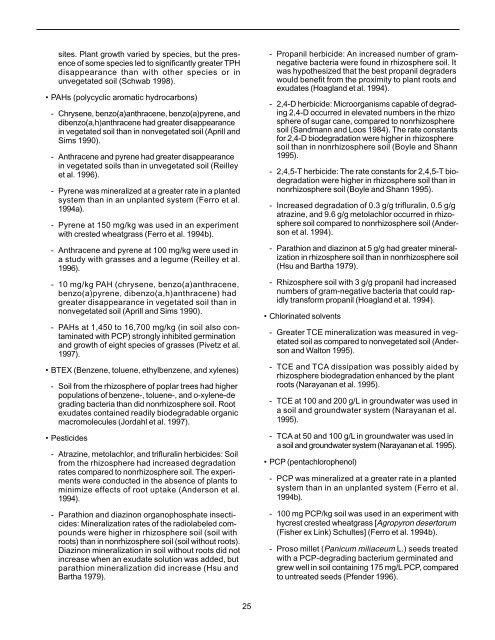Introduction to Phytoremediation - CLU-IN
Introduction to Phytoremediation - CLU-IN
Introduction to Phytoremediation - CLU-IN
You also want an ePaper? Increase the reach of your titles
YUMPU automatically turns print PDFs into web optimized ePapers that Google loves.
sites. Plant growth varied by species, but the presence<br />
of some species led <strong>to</strong> significantly greater TPH<br />
disappearance than with other species or in<br />
unvegetated soil (Schwab 1998).<br />
• PAHs (polycyclic aromatic hydrocarbons)<br />
- Chrysene, benzo(a)anthracene, benzo(a)pyrene, and<br />
dibenzo(a,h)anthracene had greater disappearance<br />
in vegetated soil than in nonvegetated soil (Aprill and<br />
Sims 1990).<br />
- Anthracene and pyrene had greater disappearance<br />
in vegetated soils than in unvegetated soil (Reilley<br />
et al. 1996).<br />
- Pyrene was mineralized at a greater rate in a planted<br />
system than in an unplanted system (Ferro et al.<br />
1994a).<br />
- Pyrene at 150 mg/kg was used in an experiment<br />
with crested wheatgrass (Ferro et al. 1994b).<br />
- Anthracene and pyrene at 100 mg/kg were used in<br />
a study with grasses and a legume (Reilley et al.<br />
1996).<br />
- 10 mg/kg PAH (chrysene, benzo(a)anthracene,<br />
benzo(a)pyrene, dibenzo(a,h)anthracene) had<br />
greater disappearance in vegetated soil than in<br />
nonvegetated soil (Aprill and Sims 1990).<br />
- PAHs at 1,450 <strong>to</strong> 16,700 mg/kg (in soil also contaminated<br />
with PCP) strongly inhibited germination<br />
and growth of eight species of grasses (Pivetz et al.<br />
1997).<br />
• BTEX (Benzene, <strong>to</strong>luene, ethylbenzene, and xylenes)<br />
- Soil from the rhizosphere of poplar trees had higher<br />
populations of benzene-, <strong>to</strong>luene-, and o-xylene-de<br />
grading bacteria than did nonrhizosphere soil. Root<br />
exudates contained readily biodegradable organic<br />
macromolecules (Jordahl et al. 1997).<br />
• Pesticides<br />
- Atrazine, me<strong>to</strong>lachlor, and trifluralin herbicides: Soil<br />
from the rhizosphere had increased degradation<br />
rates compared <strong>to</strong> nonrhizosphere soil. The experiments<br />
were conducted in the absence of plants <strong>to</strong><br />
minimize effects of root uptake (Anderson et al.<br />
1994).<br />
- Parathion and diazinon organophosphate insecticides:<br />
Mineralization rates of the radiolabeled compounds<br />
were higher in rhizosphere soil (soil with<br />
roots) than in nonrhizosphere soil (soil without roots).<br />
Diazinon mineralization in soil without roots did not<br />
increase when an exudate solution was added, but<br />
parathion mineralization did increase (Hsu and<br />
Bartha 1979).<br />
25<br />
- Propanil herbicide: An increased number of gramnegative<br />
bacteria were found in rhizosphere soil. It<br />
was hypothesized that the best propanil degraders<br />
would benefit from the proximity <strong>to</strong> plant roots and<br />
exudates (Hoagland et al. 1994).<br />
- 2,4-D herbicide: Microorganisms capable of degrading<br />
2,4-D occurred in elevated numbers in the rhizo<br />
sphere of sugar cane, compared <strong>to</strong> nonrhizosphere<br />
soil (Sandmann and Loos 1984). The rate constants<br />
for 2,4-D biodegradation were higher in rhizosphere<br />
soil than in nonrhizosphere soil (Boyle and Shann<br />
1995).<br />
- 2,4,5-T herbicide: The rate constants for 2,4,5-T biodegradation<br />
were higher in rhizosphere soil than in<br />
nonrhizosphere soil (Boyle and Shann 1995).<br />
- Increased degradation of 0.3 g/g trifluralin, 0.5 g/g<br />
atrazine, and 9.6 g/g me<strong>to</strong>lachlor occurred in rhizosphere<br />
soil compared <strong>to</strong> nonrhizosphere soil (Anderson<br />
et al. 1994).<br />
- Parathion and diazinon at 5 g/g had greater mineralization<br />
in rhizosphere soil than in nonrhizosphere soil<br />
(Hsu and Bartha 1979).<br />
- Rhizosphere soil with 3 g/g propanil had increased<br />
numbers of gram-negative bacteria that could rapidly<br />
transform propanil (Hoagland et al. 1994).<br />
• Chlorinated solvents<br />
- Greater TCE mineralization was measured in vegetated<br />
soil as compared <strong>to</strong> nonvegetated soil (Anderson<br />
and Wal<strong>to</strong>n 1995).<br />
- TCE and TCA dissipation was possibly aided by<br />
rhizosphere biodegradation enhanced by the plant<br />
roots (Narayanan et al. 1995).<br />
- TCE at 100 and 200 g/L in groundwater was used in<br />
a soil and groundwater system (Narayanan et al.<br />
1995).<br />
- TCA at 50 and 100 g/L in groundwater was used in<br />
a soil and groundwater system (Narayanan et al. 1995).<br />
• PCP (pentachlorophenol)<br />
- PCP was mineralized at a greater rate in a planted<br />
system than in an unplanted system (Ferro et al.<br />
1994b).<br />
- 100 mg PCP/kg soil was used in an experiment with<br />
hycrest crested wheatgrass [Agropyron deser<strong>to</strong>rum<br />
(Fisher ex Link) Schultes] (Ferro et al. 1994b).<br />
- Proso millet (Panicum miliaceum L.) seeds treated<br />
with a PCP-degrading bacterium germinated and<br />
grew well in soil containing 175 mg/L PCP, compared<br />
<strong>to</strong> untreated seeds (Pfender 1996).
















